
Energy in Bulgaria is among the most important sectors of the national economy and encompasses energy and electricity production, consumption and transportation in Bulgaria. The national energy policy is implemented by the National Assembly and the Government of Bulgaria, conducted by the Ministry of Energy and regulated by the Energy and Water Regulatory Commission. The state-owned company Bulgarian Energy Holding owns subsidiaries operating in different energy sectors, including electricity: Kozloduy Nuclear Power Plant, Maritsa Iztok 2 Thermal Power Plant, NEK EAD and Elektroenergien sistemen operator (ESO); natural gas: Bulgargaz and Bulgartransgaz; coal mining: Maritsa Iztok Mines. The state holds a 100% stake in the holding company. In Bulgaria, energy prices for households are state-controlled, while commercial electricity prices are determined by the market.
Verbund AG, formerly known as Verbundgesellschaft or Österreichische Elektrizitätswirtschafts-AG, is Austria's largest electricity provider. Verbund covers around 40 percent of electricity demands in Austria and generates 90 percent thereof from hydro power. In addition, Verbund operates the supraregional power grid through its subsidiary APG. Verbund AG is listed on the Vienna Stock Exchange and in the ATX, the key index of Austrian stock-listed companies. The largest shareholder, at 51%, is the Republic of Austria.
Natsionalna Elektricheska Kompania EAD (NEK) (Bulgarian: Национална електрическа компания ЕАД) is a single-owned joint-stock electric company headquartered in Sofia, Bulgaria. Bulgarian Energy Holding is the holder of the capital of NEK.

EVN Group is an Austrian-based producer and transporter of electricity, one of the largest in Europe having over three million customers in 14 countries. The company also operates in water treatment, natural gas supply and waste management business areas. It is the second-largest utility in Austria.
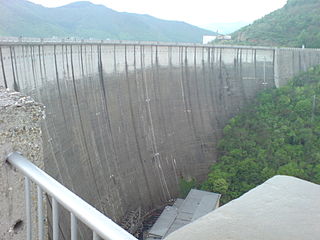
The Kardzhali Hydro Power Plant is an active hydro power near Kardzhali, southern Bulgaria constructed on the dam of the same name on the river Arda. It has 3 individual turbines with a nominal output of around 36 MW which deliver up to 108 MW of power.

The Teshel Hydro Power Plant is an active hydro power project near Teshel, Smolyan Province, southern Bulgaria. It is situated along the river Vacha in the Rhodope Mountains. It has 2 individual Francis turbines which deliver up to 60 MW of power. The Teshel HPP forms part of the Dospat–Vacha Hydropower Cascade (500.2 MW).

The Devin Hydro Power Plant is an active hydro power project in Devin, Smolyan Province, southern Bulgaria. Situated along the river Vacha in the Rhodope Mountains, it has 2 individual turbines with a nominal output of 44 MW which deliver up to 88 MW of power. It is part of the Dospat–Vacha Hydropower Cascade (500.2 MW).

The Orphey Pumpted Storage Hydro Power Plant is an active hydro power project near Krichim in the Rhodope Mountains, southern Bulgaria. It has 4 individual Francis turbines which deliver up to 164.8 MW of power. One of the turbines can be used as a pump as well, making this power plant a pumped storage type. The power plant uses water from the Vacha Reservoir along the homonymous river, and is part of the Dospat–Vacha Hydropower Cascade. The plant is named after Orpheus, who is said to have lived in these lands.
The Peshtera Hydro Power Plant is an active underground hydro power plant in Peshtera, Bulgaria, part of the Batak Hydropower Cascade. It has 5 individual Pelton turbines which can deliver up to 136 MW of power.

The Tsankov Kamak Hydroelectric Power Plant, also Tsankov Kamak HPP, comprises an arch dam and hydroelectric power plant (HPP) on the territory of the village of Mihalkovo, southwestern Bulgaria. It is situated on the Vacha River in Smolyan Province, on the borders of Pazardzhik Province and Plovdiv Province, roughly 40 kilometres (25 mi) southwest of Plovdiv and downstream (north) of the town of Devin. It is a part of the Dospat–Vacha Hydropower Cascade (500.2 MW) development of the Vacha River involving five dams and seven power stations in the provinces of Smolyan, Plovdiv and Pazardzhik, 250 kilometres (160 mi) southeast of the capital Sofia. The other four dams are Dospat, Teshel, Vacha and Krichim.
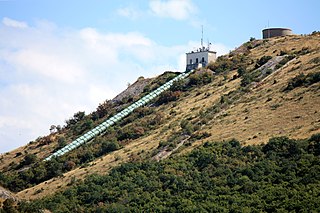
The Aleko Hydro Power Plant is an active hydro power project near Aleko Konstantinovo, Bulgaria, which is part of the Batak Hydropower Cascade. It has 3 individual Francis turbines with an installed capacity of 71.4 MW of power.

Energy in Austria describes energy and electricity production, consumption and import in Austria. Austria is very reliant on hydro as an energy source, supported by imported oil and natural gas supplies. It is planned by 2030 to become 100% electricity supplied by renewable sources, primarily hydro, wind and solar.

The Ermenek Dam is a double-curvature concrete arch dam located on the Göksu River in Karaman Province, Turkey. The 210 m (689 ft) tall dam was the highest in Turkey at the time of its construction and currently ranks third after Deriner Dam and Yusufeli Dam. The development was backed by the Turkish State Hydraulic Works. Completed in 2009, the primary purpose of the dam is to support its 300 MW power station.
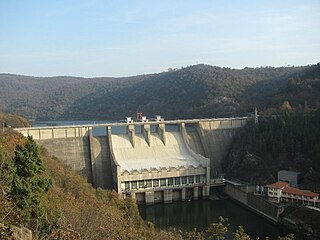
The Ivaylovgrad Dam(язовир "Ивайловград") is located in the eastern Rhodope Mountains and is situated on the Arda river, Southern Bulgaria. There are another two large dams of the Arda upstream - Kardzhali Dam and Studen Kladenets Dam to the west of Ivaylovgrad Dam.
The Lower Se San 2 Dam is a hydroelectric dam under development on the Se San River in Stung Treng Province, northeastern Cambodia. The Se San River is a major tributary of the Mekong River. The dam site is located 25 kilometres (16 mi) east of the provincial capital, also named Stung Treng. The first turbine began producing electricity in November 2017. The dam was officially opened on December 18, 2018.
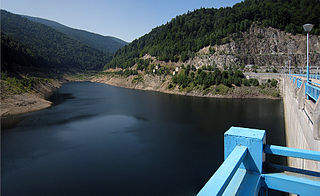
Hydroelectricity generated 11% of Bulgaria’s electricity in 2021.
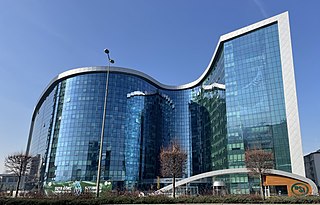
Hydroelectricity is a major source of electricity in Turkey, due to its mountainous landscape and many rivers. The country's main river basins are the Euphrates and Tigris. Over 700 hydropower plants have been built, and they make up about 30% of the country's electricity generating capacity. Annual generation varies greatly, and in rainy years lots of hydroelectric power can be generated. Government policies have generally supported building dams, but some are controversial in neighbouring countries, and some raise concerns about damage to the environment and wildlife.

Renewables supply a quarter of energy in Turkey, including heat and electricity. Some houses have rooftop solar water heating, and hot water from underground warms many spas and greenhouses. In parts of the west hot rocks are shallow enough to generate electricity as well as heat. Wind turbines, also mainly near western cities and industry, generate a tenth of Turkey’s electricity. Hydropower, mostly from dams in the east, is the only modern renewable energy which is fully exploited. Hydropower averages about a fifth of the country's electricity, but much less in drought years. Apart from wind and hydro, other renewables; such as geothermal, solar and biogas; together generated almost a tenth of Turkey’s electricity in 2022. Türkiye has ranked 5th in Europe and 12th in the world in terms of installed capacity in renewable energy. The share of renewables in Türkiye’s installed power reached to 54% at the end of 2022.
The Tapovan Vishnugad Hydropower Plant is a 520 MW run-of-river hydroelectric project being constructed on Dhauliganga River in Chamoli District of Uttarakhand, India. The plant is expected to generate over 2.5 TWh of electricity annually.













